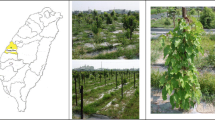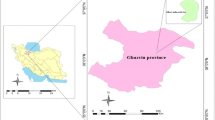Abstract
Bauxite wastewater creates soil contamination and produces toxic effects on human health such as respiratory and skin rash problems. In this study, we investigated the phytoremediation ability of Jatropha curcas to remove bauxite wastewater from soil. Pot experiments were conducted to investigate the bauxite wastewater on the phytoremediation potential of J. curcas grown in contaminated soils. J. curcas exhibited a significant increase in plant growth leaf, root activity, plant height, and plant shoot when grown in bauxite contaminated soils compared with J. curcas grown in uncontaminated soils after 30 d treatment. Under bauxite exposure, a higher aluminium removal (88.5%) was observed in soils planted with J. curcas than unplanted soils (39.6%). The bioconcentration factor was also found to be 5.62, indicating that J. curcas have great tolerance and hyperaccumulator of aluminium under high aluminium concentrations and are capable of phytoextraction of soil contaminated with bauxite wastewater.



Similar content being viewed by others
References
Ng MH, Elshikh MS (2021) Utilization of Moringa oleifera as natural coagulant for water purification. Ind Domest Waste Manag 1(1):1–11
Tang KHD, Darwish NM, Alkahtani AM, AbdelGawwad MR, Karácsony P (2022) Biological removal of dyes from wastewater: a review of its efficiency and advances. Trop Aquat Soil Pollut 2(1):59–75
Yahaghi J, Bazargan A (2022) Application of radiofrequency for decolorization, floc formation, and microorganism inactivation. Trop Aquat Soil Pollut 2(1):34–44
Al Farraj DA, Hadibarata T, Yuniarto A, Syafiuddin A, Surtikanti HK, Elshikh MS, Al Khulaifi MM, Al Kufaidy R (2019) Characterization of pyrene and chrysene degradation by halophilic Hortaea sp. B15. Bioproc Biosyst Eng 42:963–969
Hadibarata T, Tachibana S, Itoh K (2007) Biodegradation of phenanthrene by fungi screened from nature. Pak J Biol Sci 10:2535–2543
Hadibarata T, Tachibana S, Askari M (2011) Identification of metabolites from phenanthrene oxidation by phenoloxidases and dioxygenases of Polyporus sp. S133. J Microbiol Biotechnol 21:299–304
Nazifa TH, Habba N, Salmiati S, Aris A, Hadibarata T (2018) Adsorption of Procion Red MX-5B and Crystal Violet Dyes from aqueous solution onto corncob activated carbon. J Chin Chem Soc 65:259–270
Rubiyatno TZC, Lestari DV, Yulisa A, Musa M, Chen T-W, Darwish NM, AlMunqedhi BM, Hadibarata T (2022) Tolerance of earthworms in soil contaminated with polycyclic aromatic hydrocarbon. Ind Domest Waste Manag 2:9–16
Tang KHD (2021) Interactions of microplastics with persistent organic pollutants and the ecotoxicological effects: a review. Trop Aquat Soil Pollut 1:24–34
Mobtaker MM, Osanloo M (2014) In Hu Z (ed) Positive impacts of mining activities on environment, 1st edn. CRC Press, London
Ericsson M, Löf O (2019) Mining’s contribution to national economies between 1996 and 2016. Miner Econ 32:223–250
Dorin I, Diaconescu C, Topor ID (2014) The role of mining in national economies. Int J Acad Res Account Financ Manag Sci 4(3):155–160
Githiria JM, Onifade M (2020) The impact of mining on sustainable practices and the traditional culture of developing countries. J Environ Stud Sci 10:394–410
Academy of Science Malaysia (2017) Sustainable mining: case study for bauxite mining in Pahang. Academy of Science Malaysia Publishing, Malaysia
Lin S (2014) The mineral industry of Malaysia. USGS Mineral Yearbooks. https://minerals.usgs.gov/minerals/pubs/country/2014/myb3-2014-my. Accessed on 24 May 2017
Liu X, Wang Q, Deng J, Zhang Q, Sun S, Meng J (2010) Mineralogical and geochemical investigations of the Dajia Salento-type bauxite deposits, Western Guangxi China. J Geochem Explor 105(3):137–152
Nugraheni RD, Sunjaya D, Agustini S (2018) Regional tectonic and geochemical approach to distinguish bauxite characteristics in Pahang, Malaysia and West Kalimantan, Indonesia. IOP Conf Ser: Earth Environ Sci 212:012026
Horbe AMC, Anand RR (2011) Bauxite on igneous rocks from Amazonia and Southwestern of Australia: implication for weathering process. J Geochem Explor 111(1–2):1–12
Lottermoser BG (2010) Mine wastes: characterization, treatment and environmental impacts. Springer-Verlag, Berlin Heidelberg
Ushakova E, Menshikova E, Blinov S, Osovetsky B, Belkin P (2022) Environmental assessment impact of acid mine drainage from Kizel Coal Basin on the Kosva Bay of the Kama Reservoir (Perm Krai, Russia). Water 14:727
Agboola O, Babatunde DE, Fayomi OSI, Sadiku ER, Popoola P, Moropeng L, Yahaya A, Mamudu OA (2020) A review on the impact of mining operation: monitoring, assessment and management. Results Eng 8:100181
Maharjan AK, Wong DRE, Rubiyatno R (2021) Level and distribution of heavy metals in Miri River Malaysia. Trop Aqua Soil Pollut. 1(2):74–86
Wang X, Zhang Y, Lv F, An Q, Lu R, Hu P, Jiang S (2015) Removal of alkali in the red mud by SO2 and simulated flue gas under mild conditions. Environ Prog Sustain Energy 34:81–87
Qi Y (2021) The neutralization and recycling of red mud—a review. J Phys Conf Ser 1759:012004
Kobya M, Oncel MS, Demirbas E, Sik E, Akyol A, Ince M (2014) The application of electrocoagulation process for treatment of the red mud dam wastewater from Bayer’s process. J Environ Chem Eng 2(4):2211–2220
Evans K (2016) The history, challenges, and new developments in the management and use of bauxite residue. J Sustain Metal 2:316–331
Higgins D, Curtin T, Courtney R (2017) Effectiveness of a constructed wetland for treating alkaline bauxite residue leachate: a 1-year field study. Environ Sci Pollut Res Int 24(9):8516–8524
Lazou A, Ejik CVD, Tang K, Balomenos E, Kolbeinsen L, Safarian J (2021) The utilization of bauxite residue with a calcite-rich bauxite ore in the Pedersen process for iron and alumina extraction. Metall Mater Trans B 52:1255–1266
Damayanti R, Khaerunissa H (2016) Composition and characteristics of red mud: a case study on Tayan bauxite residue from alumina processing plant at West Kalimantan. Indones Min J 19(3):179–190
Huang Y (2016) A facile disposal of Bayer red mud based on selective flocculation desliming with organic humics. J Hazard Mater 301:46–55
Zuber MFAM (2019) Potential rehabilitation and phytoremediation of barren bauxite mining sites by Jatropha curcas. Int J Allied Health Sci 3(3):788
Kusin FM, Rahman MSA, Madzin ZSJ, Mohamat-Yusuff F, Ariffin M, Md ZMS (2017) The occurrence and potential ecological risk assessment of bauxite-mine impacted water and sediments in Kuantan, Pahang, Malaysia. Environ Sci Pollut Res 24(2):1306–1321
Chung JH, Hasyimah N, Hussein N (2021) Application of carbon nanotubes (CNTs) for remediation of emerging pollutants—a review. Trop Aquat Soil Pollut 2:13–26
Kristanti RA, Kambe M, Hadibarata T, Toyama T, Tanaka Y, Mori K (2012) Isolation and characterization of 3-nitrophenol-degrading bacteria associated with rhizosphere of Spirodela polyrrhiza. Environ Sci Pollut Res 19:1852–1858
Sivamani S, Kavya M, Vinusha V (2022) Treatment of hot wash liquor using fly ash. Trop Aquat Soil Pollut 2:27–33
Yan A, Wang Y, Tan SN, Yusof MLM, Ghosh S, Chen Z (2020) Phytoremediation: a promising approach for revegetation of heavy metal-polluted land. Front Plant Sci 11:359
Kristanti RA, Kanbe M, Toyama T, Tanaka Y, Tang Y, Wu X, Mori K (2012) Accelerated biodegradation of nitrophenols in the rhizosphere of Spirodela polyrrhiza. J Environ Sci 24(5):800–807
Maftuchah ZA, Winarya A, Rahmadesi Y (2020) Biodiesel generated from Jatropa (Jatropa curcas Linn.) seeds selected based on various genotypes crossbred. Energy Rep 6:345–350
Yadav SK, Juwarkar AA, Kumar GP, Thawale PR, Singh SK, Chakrabarti T (2009) Bioaccumulation and phytotrans location of arsenic, chromium and zinc by Jatropha curcas L.: impact of dairy sludge and biofertilizer. Bioresour Technol 100:4616–4622
Jamil S, Abhilash PC, Singh N, Sharma PN (2009) Jatropha curcas: a potential crop for phytoremediation of coal fly ash. J Hazard Mater 172:269–275
APHA; AWWA; WEF, (1998). Standard methods for the examination of water and wastewater. 20th. Ed. American Public Health Association, American Water Works Association and the Water Environment Federation. Washington, DC, USA
Kristanti RA, Khanitchaidecha W, Taludar G, Karácsony P, Cao LTT, Chen T-W, Darwish NM, AlMunqedhi BM (2022) A review on thermal desorption treatment for soil contamination. Trop Aqua Soil Pollut 2(1):45–58
Kristanti RA, Liong RMY, Hadibarata T (2021) Soil remediation application of nanotechnology. Trop Aqua Soil Pollut 1(1):35–45
Anning AK, Akoto R (2018) Assisted phytoremediation of heavy metal contaminated soil from a mined site with Typha latifolia and Chrysopogon zizanioides. Ecotox Environ Saf 148:97–104
Marrugo-Negrete J, Durango-Hernández J, Pinedo-Hernández J, Olivero-Verbel J, Díez S (2015) Phytoremediation of mercury-contaminated soils by Jatropha curcas. Chemosphere 127:58–63
Bose S, Vedamati J, Rai V, Ramanathan AL (2008) Metal uptake and transport by Tyaha angustata L. grown on metal contaminated waste amended soil: an implication of phytoremediation. Geoderma 145(1–2):136–142
Hegazy AK, Abdel-Ghani NT, El-Chaghaby GA (2011) Phytoremediation of industrial wastewater potentially by Typha domingensis. Int J Environ Sci Tech 8(3):639–648
US Environmental Protection Agency (2000) Introduction to phytoremediation, National Risk Management Research Laboratory, EPA/600/R-99/107. Retrieved from http://www.clu-in.org/download/remed/introphyto.pdf. Accessed on 25 May 2017
Alshaal T, Domokos-Szabolcsy É, Márton L, Czakó M, Kátai J, Balogh P, Fári M (2013) Phytoremediation of bauxite-derived red mud by giant reed. Environ Chem Lett 11(3):295–302
Baker AJM (1981) Accumulators and excluder: strategies in response of plants to heavy metals. J Plant Nutri 3(1–4):643–654
Yoon J, Cao X, Zhou Q, Ma LQ (2006) Accumulation of Pb, Cu, and Zn in native plants growing on a contaminated Florida site. Sci Total Environ 368:456–464
Hauptvogl M, Kotrla M, Prčík M, Pauková Z, Kováčik M, Lošák T (2020) Phytoremediation potential of fast-growing energy plants: challenges and perspectives—a review. Pol J Environ Stud 29(1):505–516
Acknowledgements
This research was financially supported by Kurita Water Environment Foundation Grant (Vote 17P013) which is gratefully acknowledged; additional support from the Researchers supporting project number (RSP-2021/189), King Saud University, Riyadh, Saudi Arabia.
Author information
Authors and Affiliations
Corresponding author
Ethics declarations
Conflict of interest
The authors declare that they have no conflict of interest.
Additional information
Publisher's Note
Springer Nature remains neutral with regard to jurisdictional claims in published maps and institutional affiliations.
Rights and permissions
About this article
Cite this article
Kristanti, R.A., Mardarveran, P., Almaary, K.S. et al. Phytoremediation of bauxite wastewater potentiality by Jatropa curcas. Bioprocess Biosyst Eng 46, 373–379 (2023). https://doi.org/10.1007/s00449-022-02745-5
Received:
Accepted:
Published:
Issue Date:
DOI: https://doi.org/10.1007/s00449-022-02745-5




